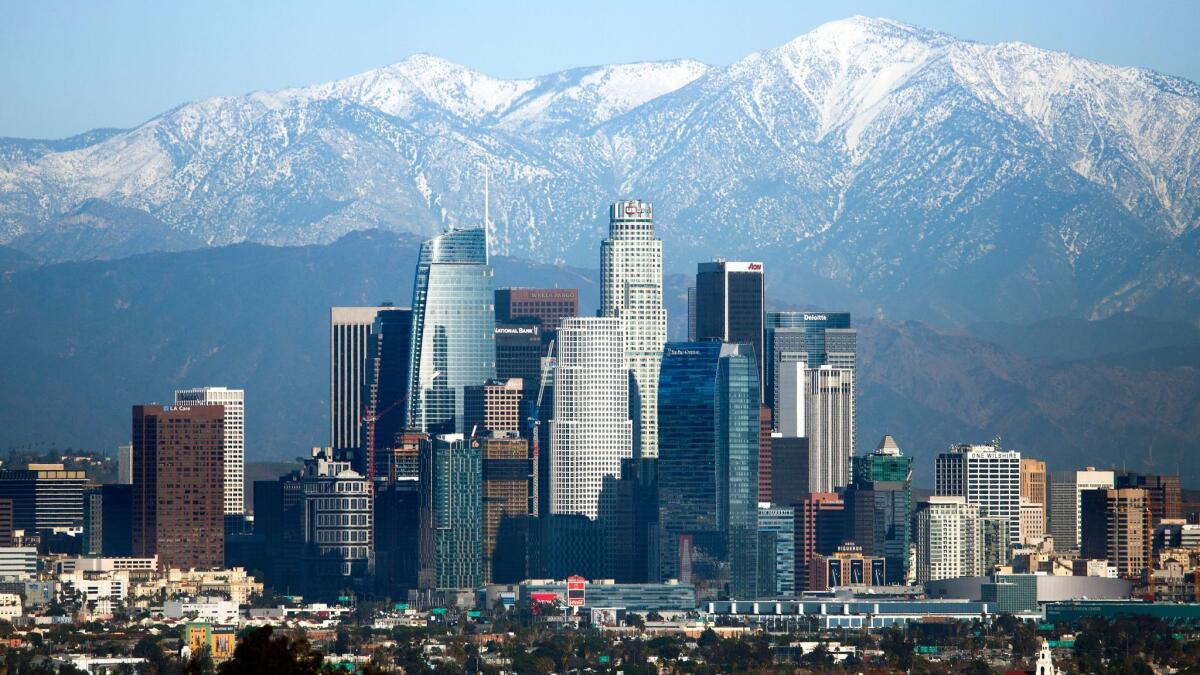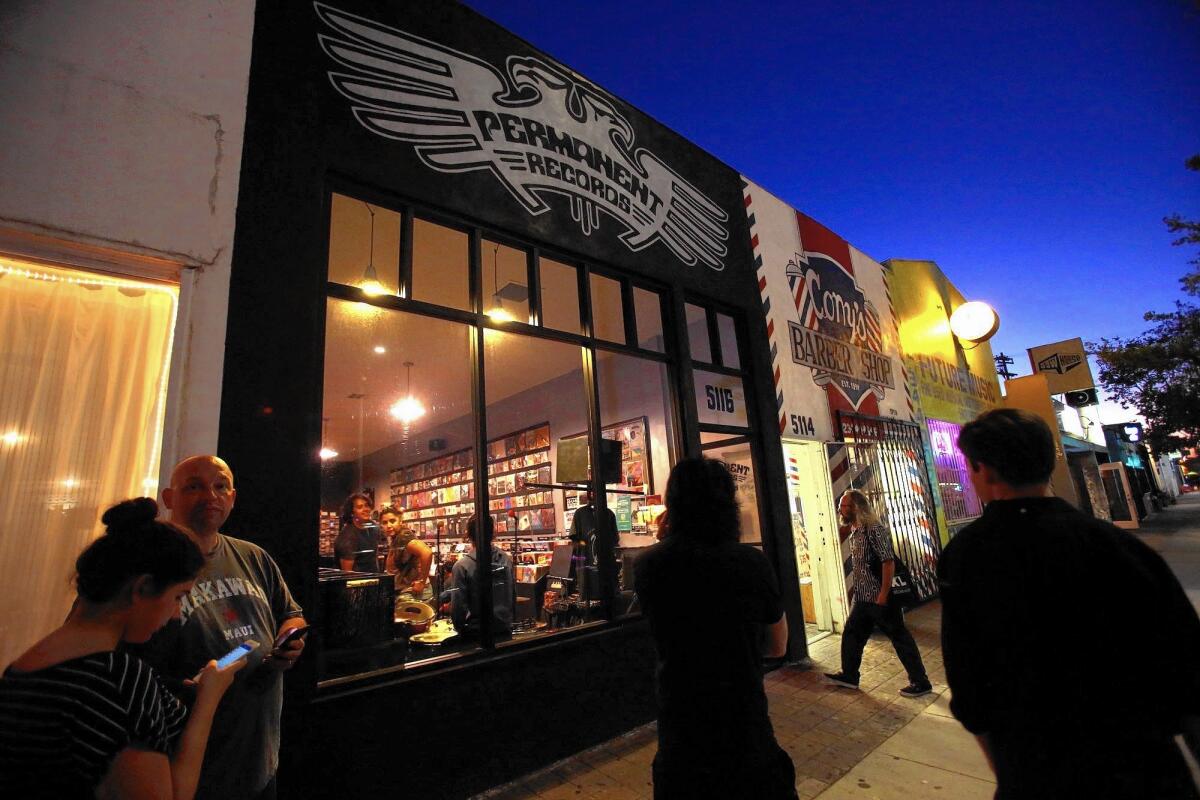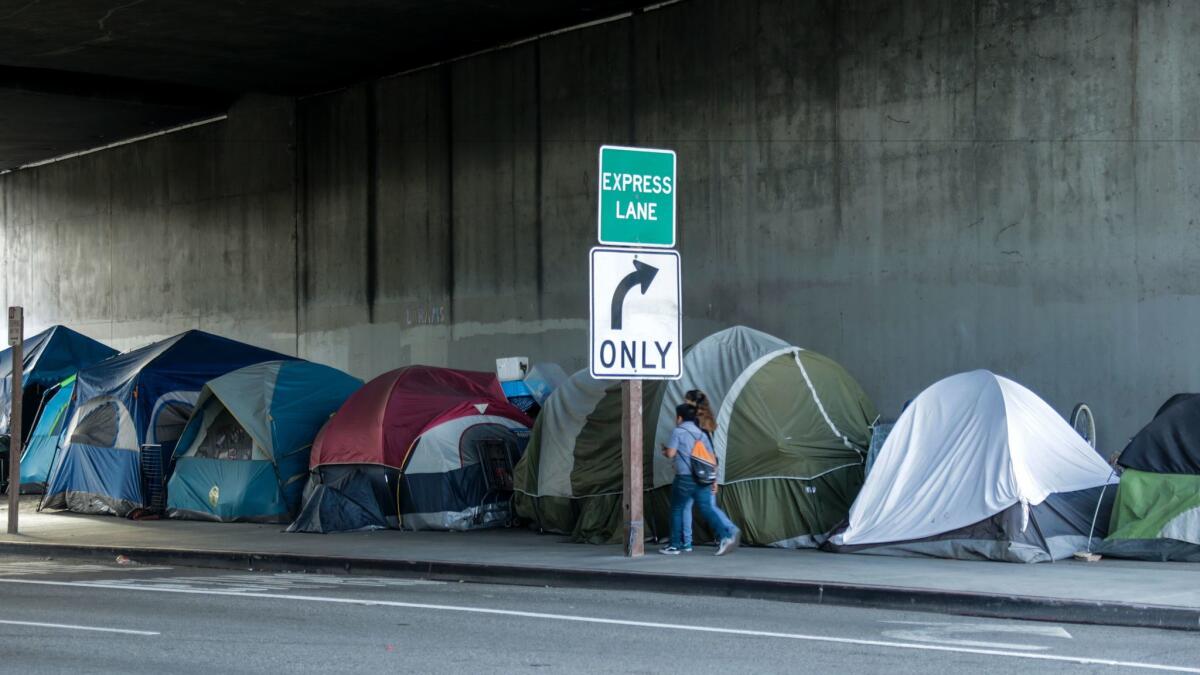Column: Everyone loves L.A. — and that’s the problem

Odd though it may seem, Los Angeles is too lucky for its own good.
Sure, the city has its share of problems, as does any metropolis. But it remains a destination for people from around the world, many of them young, skilled and creative. They move here for culture, commerce, climate — or all three.
That’s a situation many cities can only envy, but success comes at a cost. In the case of Los Angeles, our attractiveness has created a housing affordability crisis with no end in sight, transforming the city in ways big and small.
On the main shopping strip in Highland Park, where many signs are still in Spanish, a former dress shop became a groovy coffee shop two years ago — with avocado toast on the menu, of course. The customers, mostly young and white, are as self-consciously hip as the ones I used to see in Silver Lake 15 years ago.
In Boyle Heights, longtime residents have raged against the rise of art galleries, arguing that locals are being forced out, threatening the identity of the working-class Latino neighborhood.
The dark side of L.A.’s popularity
Gentrification is neither all good nor all bad, but more people in Los Angeles are falling behind rather than getting ahead, with wages flat or in decline as rents go crazy.

A book by Richard Florida, “The New Urban Crisis,” prominently features Los Angeles as a prime example of the dark side of success — severe housing shortages, deepening segregation, inequality and the decline of the middle class. In the book, the Los Angeles-Long Beach-Santa Ana metro area leads all other major hubs, including New York City, on what he calls the “urban crisis index.”
More than 400,000 households in the city of Los Angeles, and a total of 900,000 in L.A. County, have what the census bureau calls precarious housing situations. That means the dwelling is substandard, or that families are doubled up, or that they spend more than half their income on housing.
Then, of course, we’ve got 58,000 homeless people.
When I wrote about the intersection of high rent and homelessness two weeks ago, I referred to a mother and son living in their car. I then heard from a woman who said she could identify. She lives in her car and parks it at a hospital, where she gets dialysis treatments three times a week.
She was middle class. Now she’s on the street
“I was middle class up until very recently,” said the woman, in her 50s, whose name I’m withholding because she doesn’t want the hospital to know she lives in the parking lot.
I paid her a visit. She said her work as a legal secretary dried up after she got sick, so she moved in with a friend who later died. The landlord raised the rent, and she moved into her car, with no family to call on and a disability check as her only income. She’s on a waiting list for a kidney transplant, and her hope is that she’ll one day get a new kidney, go back to work, and be able to afford an apartment again. As it is, the median price for a one-bedroom apartment is $1,995, and she can’t come close to that.
When I last wrote on this topic, I heard from people who claimed they had all the answers. But for every proposed solution, there’s a counter-argument and a reality too complicated for easy fixes.
Los Angeles alone can’t solve a regional or national housing crisis, said professor Jerry Nickelsburg of the UCLA Anderson Forecast, nor can it stem the tide of people who want to live here.
“People moving into California are better-educated and have higher incomes than those who are moving out,” he said, and that’s having a direct effect on rising rents.
Calls for rent control are met with cries that such controls are unfair to landlords and drive up costs for other renters.
Why we can’t keep up with housing demands
Developers argue that eliminating red tape and simplifying environmental requirements would speed construction, and prices would drop as supply increases. Critics counter that new luxury units will far outnumber less-expensive apartments.
Los Angeles Mayor Eric Garcetti is pushing a plan for a linkage fee on new construction, requiring developers to kick into a fund for affordable housing. He claims that the idea — in use now in San Diego, San Francisco and Oakland — would raise $100 million a year and be leveraged to create $400 million in housing annually. But the development community is apoplectic, saying the proposal would slow construction and lead to higher prices.
A committee of the City Council — a body that’s beholden, some argue, to the money and clout of the real estate industry — has delayed action.
Garcetti told me he’s confident the measure will pass.
“The devil is going to be in the details,” he said.
Garcetti has a lot on the line, because the fee is a central piece of his plan to address the housing crisis. Another key is completion of a general plan that would allow greater housing density in areas where it makes sense, such as near transit corridors.
Peter Dreier, a professor at Occidental College, helped design a linkage fee for the city of Boston, when he worked there many years ago. “Everyone in Boston said it would kill the golden goose of prosperity, but we ignored them,” said Dreier, and Boston continued to prosper.
Dreier said Los Angeles needs to build more affordable housing, but also has to preserve what’s left of a dwindling number of affordable homes. They’re being lost partly because when tenants move out of units built prior to 1978, the landlord can raise rents to any level. A bill that would give cities more power to cap rent increases has Garcetti’s support, but it’s been stalled in Sacramento under heavy pressure from landlords.

In some cases, landlords have a legitimate beef. I visited Loretta and Henry Selinger, who own seven midsize apartment buildings in the Mar Vista area, with a total of 97 units. Some of their longtime tenants are paying as little as $900 a month, despite healthy incomes, for units that could rent for twice that much. The Selingers can’t raise the rent more than 3% to 5% a year, even when they invest thousands for building improvements and seismic safety upgrades.
“We’re not crying poverty,” said Loretta, but the Selingers think it’s unfair to require them to charge far less than they could get in a free market.
An agenda for fixing L.A.
So what to do?
In Florida’s book, which Garcetti recommended to me, the fixes include some of what Los Angeles has done or is doing. Build more transit, which creates more jobs and connects more people to paychecks and housing. Build denser housing near transportation hubs. Build more affordable rental housing, as the linkage fee would make possible. And address the other end of the challenge — flat or declining wages in the service industry — by increasing the minimum wage for people whose work supports the robust economy that draws so many people to L.A.
Florida also calls for eliminating restrictive zoning and building codes to make way for higher-density projects. He recommends taking billions in federal subsidies for mortgage deductions that go to some of the wealthiest people in the country, and kicking it into housing or housing assistance. Why not tax property on its usefulness, argues Florida, with lower taxes on property that serves a great public need such as affordable housing? And why aren’t tech giants, at the center of the new economy of winners and losers, doing more to support their own service employees or joining the search for broader fixes?
Donald Trump said he was going to rebuild cities, but his budget proposals seem to have a different objective in mind, and would cost cities millions in housing funds. All the more reason for cities to figure out what they can do on their own, or in conjunction with officials from other cities and the state.
If the L.A. City Council doesn’t want to support a linkage fee, fine. But in that case, it damn well better come up with something else.
Get more of Steve Lopez’s work and follow him on Twitter @LATstevelopez
More from Steve Lopez:
Customers battle Whole Foods to save a newsstand, and a way of life
Dying malls offer a chance to build something better — and address how our lives are changing
L.A.’s crisis: High rents, low pay, homelessness rising and $2,000 doesn’t buy much
More to Read
Sign up for Essential California
The most important California stories and recommendations in your inbox every morning.
You may occasionally receive promotional content from the Los Angeles Times.











